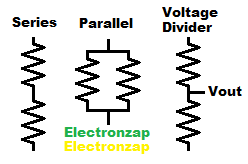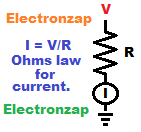Table of Contents
Resistors limit current based on the voltage across them and/or can set a signal voltage (not for power) when the amount of current through the resistor is set in some way.

- Lone resistor limits current based on its resistance and the voltage across it.
- Multiple resistor in series add up their resistance (and divide the voltage which can be used as a voltage divider.
- Parallel resistors all pass current based on the voltage across them. Those currents add up. More current means that they provide less resistance than any of them alone.
- Voltage divider uses the voltage across one of the resistances (at a node) to be a reference voltage for other circuitry.
Current Limiting:

You can set a current of a circuit by controlling the voltage that is across the resistor. Current (I) through a resistor is the voltage across it divided by it’s resistance. Ohms law formula for current is I = V/R
Instead of/or in addition to a resistor, a current source can be used to set current through a series circuit even as the supply voltage changes. The resistor just reduces the voltage across the current source, unless there isn’t enough voltage to provide the desired current to the circuit.
Current limiting resistors are often used to protect little indicator LEDs.
Voltage divider

You can set a voltage across a resistance if you control the current flowing through it.
Multiple resistances divide up the total voltage when you measure at the points where they connect. Usually that voltage is in relationship to ground (negative supply for single supply DC).
The voltage is just a signal (something for other circuitry to respond to or use as a reference). The more current you demand of a voltage divider, the more it will throw of the voltage at the node in question.